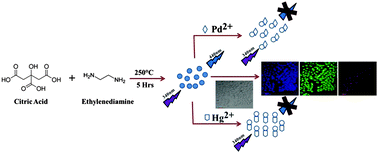Multicolour fluorescent carbon nanoparticle probes for live cell imaging and dual palladium and mercury sensors†
Abstract
Carbon based nanomaterials are emerging as a desirable alternative to semiconducting quantum dots due to their unique optical properties and biocompatibility. The present study demonstrates the design and synthesis of highly fluorescent carbon nanoparticles (CNPs). The CNPs are investigated for their biocompatibility and henceforth successfully employed as promising multicolor bioimaging probes in A375 and DU145 cell lines. Furthermore, a “turn off” mode has been established for the detection of noble metal palladium (Pd2+) and heavy metal mercury (Hg2+) by quenching the fluorescence of CNPs. The CNP sensor responded to the detection of Pd2+ (5–100 μM) and Hg2+ (1–18 μM) in a wide range with the limit of detection (LOD) of 58 nM for Pd2+ and 100 nM for Hg2+. The CNP sensor was employed for the detection of Pd2+ and Hg2+ in real water samples and detection of leftover palladium catalysts in a model reaction system. Also, the CNPs were successfully employed as intracellular mercury and palladium sensors using confocal microscopy.

- This article is part of the themed collections: JMC B Editor’s choice web collection: ‘‘seeing the unseen updated: advances in biosensing’’ and 2016 Journal of Materials Chemistry B Most Accessed Manuscripts

 Please wait while we load your content...
Please wait while we load your content...